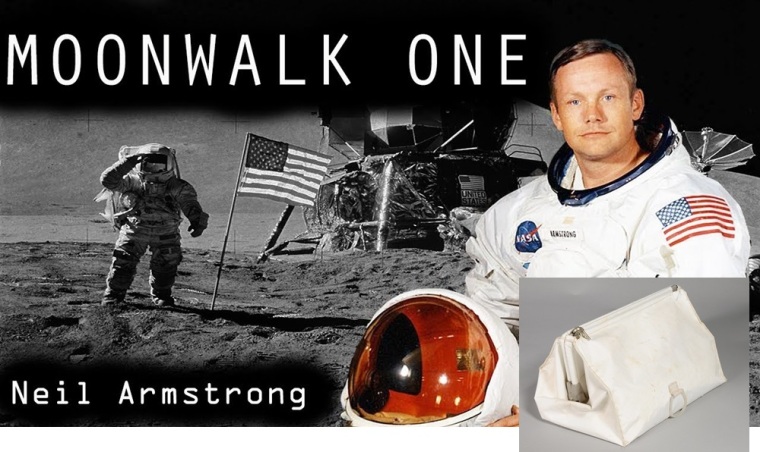Neil Armstrong's Wife Discovers White Bag Full of Secrets from Historic Moon Landing

A white purse especially designed for space flight was recently discovered by the widow of Neil Armstrong, the first man who ever walked on the Moon.
Inside the shabby white holdall, Carol Armstrong found a handful of souvenirs from mankind's first landing on the Moon in 1969 that Armstrong secretly kept for years, a Time report said.
Carol Armstrong reported the historic finding to the National Air and Space Museum, which unveiled new details about the bag's contents in a blog post published on Feb. 6.
Allan Needell, the curator at the museum's Space History Department, said the Armstrong Family has agreed to donate the late astronaut's correspondence and paper files to his alma mater, Purdue University.
Needell explained that the bag itself was immediately recognizable in that the Apollo Lunar Surface Journal long has had a page devoted to what the astronauts referred to as a McDivitt Purse.
"The purse was a special container – officially called a Temporary Stowage Bag, or TSB – stowed in the Lunar Module during launch but especially fitted with pins that fit into sockets in front of the Commander's station to the left of the Lunar Module hatch. The TSB looks like a clutch purse in the way it opens and closes," Needell explained in the blog
"The astronauts referred to it as a McDivitt purse, apparently because the need for a bag to temporarily stow items when there wasn't time to return them to fixed stowage locations was first suggested by Apollo 9 Commander James McDivitt," he added.
Needle said Armstrong, who died due to complications following a heart surgery in 2012, never discussed the existence of the white bag including the items inside it since his return from the moon 45 years ago.
Out of all the items inside, the curator cited two items that stood out from the pack: the 16mm Data Acquisition Camera that was mounted in the window of the lunar module Eagle, and two waist tethers provided in the lunar module.
"The first is the 16mm Data Acquisition Camera that was mounted in the window of the lunar module Eagle to record the historic landing and "one small step" made by Armstrong as humankind first set foot on another world," Needell said.
"The second is one of two waist tethers provided in the lunar module explicitly for securing astronauts should they have to spacewalk from the Lunar Module back to the Command Module had there been a problem reconnecting the two spacecraft in orbit around the Moon," he added.
Both items have been placed on display as part of the recently opened temporary exhibition "Outside the Spacecraft: 50 Years of Extra-Vehicular Activity."
 Christians don't have to affirm transgenderism, but they can’t express that view at work: tribunal
Christians don't have to affirm transgenderism, but they can’t express that view at work: tribunal Archaeology discovery: Medieval Christian prayer beads found on Holy Island
Archaeology discovery: Medieval Christian prayer beads found on Holy Island Presbyterian Church in America votes to leave National Association of Evangelicals
Presbyterian Church in America votes to leave National Association of Evangelicals Over 50 killed in 'vile and satanic' attack at Nigerian church on Pentecost Sunday
Over 50 killed in 'vile and satanic' attack at Nigerian church on Pentecost Sunday Ukrainian Orthodox Church severs ties with Moscow over Patriarch Kirill's support for Putin's war
Ukrainian Orthodox Church severs ties with Moscow over Patriarch Kirill's support for Putin's war Islamic State kills 20 Nigerian Christians as revenge for US airstrike
Islamic State kills 20 Nigerian Christians as revenge for US airstrike Man who served 33 years in prison for murder leads inmates to Christ
Man who served 33 years in prison for murder leads inmates to Christ


 Nigerian student beaten to death, body burned over ‘blasphemous’ WhatsApp message
Nigerian student beaten to death, body burned over ‘blasphemous’ WhatsApp message 'A new low': World reacts after Hong Kong arrests 90-year-old Cardinal Joseph Zen
'A new low': World reacts after Hong Kong arrests 90-year-old Cardinal Joseph Zen Iran sentences Christian man to 10 years in prison for hosting house church worship gathering
Iran sentences Christian man to 10 years in prison for hosting house church worship gathering French Guyana: Pastor shot dead, church set on fire after meeting delegation of Evangelicals
French Guyana: Pastor shot dead, church set on fire after meeting delegation of Evangelicals ‘Talking Jesus’ report finds only 6% of UK adults identify as practicing Christians
‘Talking Jesus’ report finds only 6% of UK adults identify as practicing Christians Mission Eurasia ministry center blown up in Ukraine, hundreds of Bibles destroyed: 'God will provide'
Mission Eurasia ministry center blown up in Ukraine, hundreds of Bibles destroyed: 'God will provide' Church holds service for first time after ISIS desecrated it 8 years ago
Church holds service for first time after ISIS desecrated it 8 years ago Burger King apologizes for 'offensive campaign' using Jesus' words at the Last Supper
Burger King apologizes for 'offensive campaign' using Jesus' words at the Last Supper Uganda: Muslims abduct teacher, burn him inside mosque for praying in Christ’s name
Uganda: Muslims abduct teacher, burn him inside mosque for praying in Christ’s name